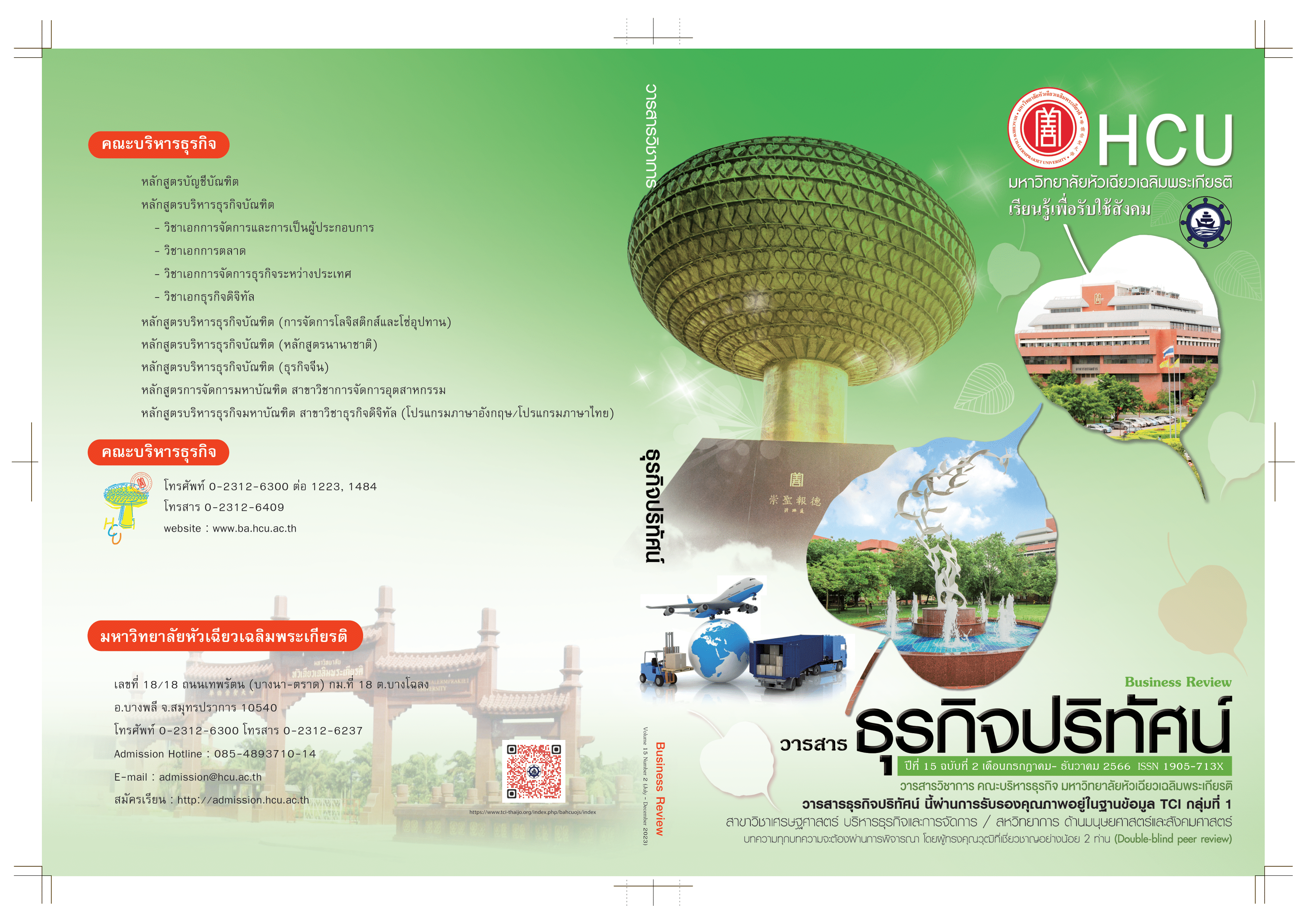The Effect of Self-Efficacy and Job Resources on Work Engagement: A Case Study of Correctional Officers in Pathumthani Province
Keywords:
Self-efficacy, Job resources, Work engagementAbstract
The purposes of this research are; 1) to study a level of self-efficacy, job resources, and work engagement. 2) to study a relation between self-efficacy and work engagement. 3) to study a relation between job resources and work engagement. 4) to study an effect of self-efficacy and job resources on work engagement. The sample were 276 employees of the correction department. This research employs a quantitative research method by selecting the sample group with quota sampling and accidental sampling technique. The research instruments were the questionnaire. The data were analysed by using frequency, percentage, mean, standard deviation, correlation analysis, and multiple regression analysis. The research findings are summarized that the level of self-efficacy, job resources, and work engagement are in high level. Self-efficacy and job resources positively correlates with work engagement at the statistically significant level of .01. The multiple regression analysis shows that self-efficacy, autonomy, and supervisory coaching positively affect work engagement at the statistically significant level of .05. In addition, these variables are significant predictors for work engagement with predictability of 34%.
References
กรมราชทัณฑ์. (2558). แผนปฏิบัติราชการ กรมราชทัณฑ์ พ.ศ. 2559-2562. สืบค้นเมื่อ 15 สิงหาคม 2562 เว็บไซต์: http://www.oic.go.th/FILEWEB/CABINFOCENTER11/DRAWER052/GENERAL/DATA0000/00000124.PDF
สุทัตตา พานิชวัฒนะ. (2560). การรับรู้ความสามารถของตนเอง ทรัพยากรในงาน และความผูกพันในงานโดยมีความต้องการของงานที่ท้าทายเป็นตัวแปรกำกับ. วิทยานิพนธ์ปริญญาศิลปศาสตรมหาบัณฑิต, มหาวิทยาลัยธรรมศาสตร์.สำนักงานจังหวัดปทุมธานี. (2562). แผนพัฒนาจังหวัดปทุมธานี พ.ศ.2561-2564. สืบค้นเมื่อ 19 สิงหาคม 2562, เว็บไซต์: http://www.aecthaibiz.com/wapppcoc/13/upload/File_IPD_FILE13429824_20180425_115121.pdf
สำนักงานสถิติแห่งชาติ. (2562). อาชญากรรมและความผิดที่มีโทษทางอาญา. สืบค้นเมื่อ 19 สิงหาคม 2562, เว็บไซต์: http://statbbi.nso.go.th/staticreport/page/sector/th/09.aspx
Altunel, M. C., Kocak, O. E., & Cankir, B. (2015). The effect of job resources on work engagement: A study on academicians in Turkey. Educational Sciences: Theory and Practice, 15(2), 409-417.
Alzyoud, Adel A. Y., Othman, Siti Z. & Isa, Mohd F. Mohd. (2015). Examining the Role of Job Resources on Work Engagement in the Academic Setting. Asian Social Science, 11(3), 103-110.
Ariani, D. W. (2013). The Relationship between Employee Engagement, Organizational Citizenship Behavior, and Counterproductive Work Behavior. International Journal of Business Administration, 4(2), 46-56.
Bakker, A. B., and Bal, P. M. (2010). Weekly Work Engagement and Performance: A Study among Starting Teachers. Journal of Occupational and Organization Psychology, 83(1), 189-206.
Bakker, A. B., & Demerouti, E. (2007). The job demands-resources model: State of the art. Journal of Managerial Psychology, 22(3), 309-328.
Bakker, A. B., Demerouti, E., & Sanz-Vergel, A. I. (2014). Burnout and Work Engagement: The JD-R Approach. Annual Review of Organizational Psychology and Organizational Behavior, 1, 389-411.
Bakker, A. B., Hakanen, J. J., Demerouti, E., & Xanthopoulou, D. (2007). Job resources boost work engagement, particularly when demands are high. Journal of Educational Psychology, 99(2), 274-294.
Bandura, A. (1986). Social foundations of thought and action: A social cognitive theory Englewood Cliffs. New Jersey: Prentice-Hall.
Bhatnagar, J. (2012). Management of innovation: role of psychological empowerment, work engagement and turnover intention in the Indian context. The international journal of human resource management, 23(5), 928-951.
Chaudhary, R., Rangnekar, S., & Barua, M. K. (2012). Relationships between occupational self-efficacy, human resource development climate, and work engagement. Team Performance Management: An International Journal, 18(7/8), 370-383.
Chen, G., Gully, S. M., & Eden, D. (2001). Validation of a new general self-efficacy scale. Organizational research methods, 4(1), 62-83.
Crawford, E. R., LePine, J. A., & Rich, B. L. (2010). Linking job demands and resources to employee engagement and burnout: a theoretical extension and meta-analytic test. Journal of Applied Psychology, 95(5), 834-848.
Federici, R. A., & Skaalvik, E. (2011). Principal self-efficacy and work engagement: Assessing a Norwegian principal self-efficacy scale. Social Psychology of Education, 14(4), 575-600.
Hackman, J. R., & Oldham, G. R. (1975). Development of the Job Diagnostic Survey. Journal of Applied Psychology, 60(2), 157-170.
Halbesleben, J. R. B. (2010). A meta-analysis of work engagement: Relationships with burnout, demands, resources, and consequences. In A. B. Bakker, & M. P. Leiter (Eds.), Work engagement: A handbook of essential theory and research (p.102-117). New York: Psychology Press.
Hakanen, J. J., Bakker, A. B., & Schaufeli, W. B. (2006). Burnout and work engagement among teachers. Journal of School Psychology, 43, 495-513.
Hobfoll, S. E. (2002). Social and Psychological Resources and Adaptation. Review of General Psychology, 6, 307–324.
Hu, Q., Schaufeli, W. B., & Taris, T. W. (2011). The Job Demands-Resources Model: An analysis of additive and joint effects of demands and resources. Journal of Vocational Behavior, 79(1), 181-190.
Kahn, W. A. (1990). Psychological conditions of personal engagement and disengagement at Work. Academy of management journal, 33(4), 692-724.
Kotze, M. (2018). How job resources and personal resources influence work engagement and burnout. African Journal of Economic and Management Studies, 9(2), 148-164.
Krejcie, R. V., & Morgan, E. W. (1970). Determining sample size for research activities. Educational and Psychological Measurement, 30(3), 607-610.
Luthans, F. (1989). Organization behavior. New York: McGraw-Hall.Nawrin, R. (2019). Determinants of work engagement and the mediating role of meaningful work in Bangladesh private bank. Dissertation for the degree of doctor of philosophy, National Institute of Development Administration.
Petchsawang, P., & McLean, G. N. (2017). Workplace spirituality, mindfulness meditation, andwork engagement. Journal of Management, Spirituality & Religion, 14(3), 216-244.
Saks, A. M. (2006). Antecedents and consequences of employee engagement. Journal of Management Psychology, 21(7), 600-619.
Schaufeli, W. B., & Bakker, A. B. (2004). Job demands, job resources, and their relationship with burnout and engagement: A multi-sample study. Journal of Organizational Behavior, 25, 293-315.
Schaufeli, W. B., Bakker, A. B., & Salanova, M. (2006). The measurement of work engagement with a short questionnaire: A cross-national study. Educational and psychological measurement, 66(4), 701-716.
Schaufeli, W. B., Salanova, M., Gomzalez- Roma, V., & Bakker, A. B. (2002). The measurement of engagement and burnout: A two sample confirmatory factor analytic approach. Journal of Happiness Studies, 3(1), 71-92.
Stajkovic, A. D., & Luthans, F. (1988). Self-efficacy and work-related performance: A meta-analysis. Psychological Bulletin, 124(2), 240-261.
Takawira, N., Coetzee, M., & Schreuder, D. (2014). Job embeddedness, work engagement and turnover intention of staff in a higher education institution: An exploratory study. SA Journal of Human Resource Management, 12(1), 1-10.
Xanthopoulou, D., Bakker, A.B., Demerouti, E. and Schaufeli, W.B. (2007). The role of personal resources in the job demands-resources model. International Journal of Stress Management, 14(2), 121-141.
Downloads
Published
How to Cite
Issue
Section
License
Copyright (c) 2023 Business Review Journal

This work is licensed under a Creative Commons Attribution-NonCommercial-NoDerivatives 4.0 International License.
All articles published in the Business Administration and Management Journal Review are copyrighted by the journal.
The views and opinions expressed in each article are solely those of the individual authors and do not represent those of Huachiew Chalermprakiet University or any other faculty members. Each author is fully responsible for the content of their own article. Any errors or issues found are the sole responsibility of the respective author.




